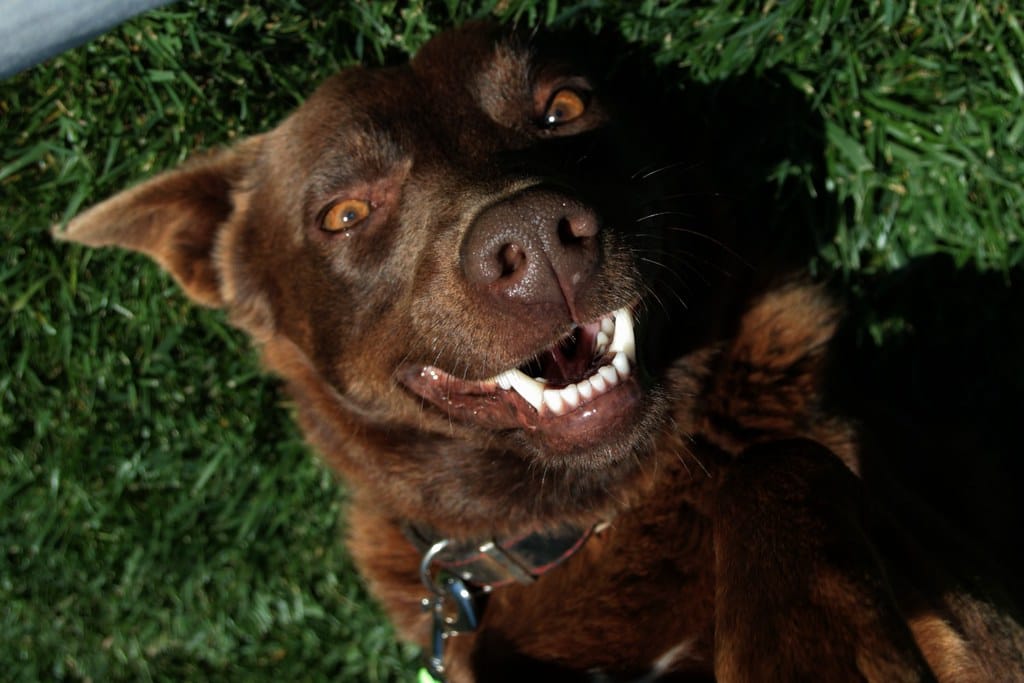Have you ever noticed your furry friend flashing what seems to be a smile, but not quite sure what it means? Get ready to embark on an enlightening journey into the world of dog body language as we decode the mystery behind your dog's "submissive grin."

This engaging blog post will unravel the complexities of this fascinating expression, helping you to better understand and connect with your canine companion. So, if you're intrigued by the thought of getting to know what goes on in your dog's mind when they offer you that peculiar grin, stay tuned as we dive into the heartwarming world of our beloved pets and their unique ways of communicating.
Introduction to the Submissive Grin
In the nuanced world of canine communication, a dog's smile can convey a plethora of meanings. Among these is the 'submissive grin,' a specific facial expression that is part of the complex language dogs use to interact with their environment. This particular gesture is characterized by a dog pulling back its lips and showing its teeth, often accompanied by a lowered body posture or a wagging tail.
While this may resemble a human smile, it's important to distinguish it from other types of dog smiles, such as the relaxed 'open-mouth' smile often seen during play or moments of contentment. The submissive grin is a more calculated display, typically used by dogs to signal non-aggression, deference, or appeasement to other dogs or humans.
Understanding and correctly interpreting your dog's body language, including the submissive grin, is crucial for fostering a healthy relationship with your pet. Misinterpretation can lead to confusion and may even reinforce undesirable behaviors. For instance, the submissive grin should not be mistaken for aggression, as the showing of teeth may imply. Rather, it is a dog's way of indicating that they are not a threat, want to avoid conflict, or are feeling anxious. Recognizing these subtleties can help you respond appropriately to your dog's needs and emotions, strengthening the bond you share.
Recognizing the submissive grin and other forms of canine body language is not just about improving the human-animal bond; it also speaks volumes about the social savvy of dogs. Research has shown that dogs are adept at reading human gestures and expressions, which suggests that they are equally expressive when it comes to their own emotions. Dogs display submissive behaviors for a variety of reasons, often as a part of their instinctual pack mentality where showing submission helps maintain social harmony. In a domestic context, these behaviors can be a signal to their human family members, indicating that they want to please and are willing to follow their lead.
As we delve deeper into understanding why dogs display submissive behavior, the next section will explore the scientific underpinnings of this form of communication. We will examine the evolutionary purpose of submissive expressions in canines, how their facial muscles facilitate these expressions, and the impact this has on their interactions with both humans and other dogs. This exploration will provide a foundation for interpreting and responding to the submissive grin in a way that supports a dog's emotional well-being and reinforces a positive human-dog relationship.
The Subtle Art of the Submissive Grin in Canines

The Evolutionary Tapestry
The concept of the submissive grin in dogs is a tapestry woven from the threads of evolution. Far from being a mere smile, this complex signal serves as a cornerstone in the intricate language of canine communication. It's an emblem of peace, a relic from the time when the paths of humans and dogs first intertwined. The domestication journey has sculpted dogs' facial expressions, making them finely attuned to human attention. Among these expressions, the submissive grin stands out as a pivotal evolution, crafted to convey non-aggression and foster harmony within the social tapestry of humans and dogs alike.
- Origin: A non-aggressive gesture promoting peaceful interactions.
- Domestication Effect: Enhanced responsiveness of facial expressions to human attention.
The Anatomy of Canine Expressions
Delving into the anatomy behind the submissive grin reveals a fascinating interplay of muscles, particularly around the eyes and mouth. These muscles are the artists behind the canvas of emotions dogs display. The levator anguli oculi medialis muscle, for example, plays a starring role in crafting the submissive grin. Its pronounced development in dogs, as opposed to their wolf ancestors, underscores the evolutionary advantage bestowed upon those who could 'speak' to humans through their expressions.
- Key Muscles: Facial muscles around the eyes and mouth.
- Evolutionary Advantage: Enhanced communication with humans.
The Dance of Interaction
When a dog flashes a submissive grin, it's engaging in a silent dialogue with its human counterpart. This expression, often perceived as a token of friendliness, shapes the human response in kind. The warmth and positivity elicited by a submissive grin can reinforce this behavior in dogs, encouraging its recurrence. This reciprocal exchange is the bedrock of the profound bond shared between dogs and humans, a dance of interaction choreographed by evolution.
- Human Perception: Viewed as a friendly gesture.
- Reinforcement: Positive human responses encourage the behavior's repetition.
Emotions in Motion
The realm of canine emotions and their expressions, such as the submissive grin, is a vibrant area of research. These expressions are not mere reflexes but are imbued with a spectrum of emotions, from insecurity to a yearning for peace. Understanding the emotional currents beneath the surface of a submissive grin is crucial for owners to navigate the waters of canine well-being and behavior.
- Research Focus: Link between dogs' emotions and their facial expressions.
- Significance: Understanding underlying emotions aids in appropriate human responses.
Beyond the Grin: Interpreting Canine Body Language
The narrative of a submissive grin gains depth when viewed against the backdrop of a dog's overall body language. The upcoming section will illuminate how to decode this silent language, offering insights into the symphony of postures and expressions that comprise canine communication.
- Contextual Interpretation: The importance of considering overall posture and behavior.
- Insightful Guidance: Techniques for recognizing and interpreting canine body language cues.

Interpreting Your Dog's Body Language
Recognizing and understanding the nuances of a dog's body language is crucial for effective communication between humans and their canine companions. A submissive grin is a particular expression that dogs exhibit, characterized by a pulled-back lips to reveal teeth, often in a non-aggressive manner. It's essential to distinguish this grin from other types of dog smiles, such as those stemming from relaxation or happiness. A submissive grin typically accompanies other signs of submissiveness or appeasement in a dog's body language. This expression can be a response to a human's direct approach, a gesture of reconciliation towards another dog, or a signal to convey that they are not a threat.
The key features that help identify a submissive grin include the lip movements that expose the front teeth, sometimes accompanied by averting gaze, lower ear positioning, and a lowered body stance. These physical cues are signals meant to demonstrate a dog's deference to another being. The tail position also plays a significant role; a submissive dog may wag its tail low or tuck it between its legs, as opposed to the high, stiff wagging associated with aggression. Recognizing these combined signals can prevent misinterpretation of a dog's intentions, allowing for a more harmonious human-dog relationship. A study by the University of Veterinary Medicine, Vienna, supports the idea that specific body postures in dogs are indicative of their emotional states and intentions.
Submissive grins are more common in some social situations than others. For example, when a dog is greeted by someone they perceive as higher status or when they are being scolded, they may display a submissive grin as a peace-making gesture. It's also not uncommon for dogs to use this expression during play as a way to signal that their rough behavior is not meant aggressively. Furthermore, certain breeds may show a predisposition towards submissive behavior, including grins, because of their history, genetics, or temperament. It is important to note that while some breeds may share common traits, individual variation is substantial, and getting to know a dog's personal communication style is key.
Understanding these expressions in the context of the dog's overall body language and the situation is vital. The next section will delve into the appropriate human responses to a dog's submissive grin, with a focus on training and reinforcing techniques to promote confidence and happiness in your furry friend. Learning to respond correctly to a dog's submissive signals can contribute to a stronger, more trusting relationship and better emotional health for the dog.

Responding to Your Dog's Submissive Grin
Recognizing a submissive grin in our canine companions is not just about understanding them better; it also shapes our response to their communication efforts. When a dog exhibits a submissive grin, it is often a sign of appeasement, respect, or a desire to signal non-threatening intentions. The appropriate human response should be calm and reassuring, as overreacting can confuse the dog or even reinforce the submissive behavior. It's crucial to approach your dog in a non-threatening manner, using a soft voice and gentle petting, to communicate that there is no danger and that they are safe.
Training and reinforcement techniques are essential tools in helping your dog gain confidence. Consistency in training allows dogs to understand what is expected of them, reducing their anxiety and the need to display submissive behaviors excessively. Positive reinforcement, such as treats or praise for confident behavior, can be more effective than punishment, as it builds trust rather than fear. According to a study by the Journal of Veterinary Behavior, positive reinforcement methods can enhance the human-animal bond and lead to better training outcomes.
While a submissive grin is a normal part of canine behavior, excessive submission can be a sign of underlying issues such as fear, anxiety, or past trauma. It is essential to monitor your dog's body language and behavior to determine if their submissive displays are within a healthy range or if they indicate a deeper problem. If a dog regularly shows excessive submission, it may be beneficial to consult with a veterinarian or an animal behaviorist to identify the root cause and develop a plan to address it.
The role of positive reinforcement in building a trusting relationship with your dog cannot be overstated. It not only encourages them to repeat desired behaviors but also helps in creating a more secure and confident companion. By acknowledging and rewarding signs of confidence, you can gradually help your dog reduce unnecessary submissive grins. This balanced approach to responding to your dog's submissive grin fosters a stable and constructive dynamic, paving the way for a pet that feels secure in its environment and in its interactions with you.
As we continue to explore the nuances of canine communication, the next section will delve into advanced tools that can help us monitor and understand our dog's behavior more comprehensively.

Tools to Monitor and Understand Your Dog's Behavior
In the digital age, pet owners have access to innovative tools that can significantly enhance their understanding of their dog's behavior. One such tool is the Fi Smart GPS Tracking Dog Collar, a device designed to monitor a dog's activity and pinpoint their location in real time. The collar is equipped with a GPS tracker, providing owners with peace of mind regarding their pet's whereabouts.
This advanced technology does more than just track location; it offers insights into the dog's behavior patterns. By analyzing the data collected, owners can identify trends in their dog's activity levels and movements throughout the day. Such information can be crucial in understanding the context of certain behaviors, such as a submissive grin. If a dog displays submissive behaviors more frequently during certain times or in specific locations, this could indicate underlying stressors or triggers in those situations.
The benefits of GPS tracking extend beyond behavior analysis. The safety and well-being of the pet are paramount, and a GPS tracking collar can be a lifesaver in the event that a dog goes missing. Being able to quickly locate a lost dog reduces the time they are exposed to potential dangers and can prevent a situation from becoming a full-blown crisis. The assurance that comes with the ability to locate a pet at any time is invaluable to many pet owners.
Moreover, smart collars often come with additional features that aid in dog behavior analysis. They may include activity monitoring, which helps owners ensure their dogs are getting enough exercise, and sleep tracking, which can highlight changes in rest patterns that might signal health issues. Some collars even offer the ability to set up virtual geofences, alerting owners when their pets leave a designated safe area. These features provide a comprehensive picture of a dog's well-being, allowing owners to make informed decisions about their pet's health and lifestyle.
As we delve into the capabilities and advantages of smart collars, it becomes clear that these devices can play a crucial role in understanding and managing a dog's behavior. In the next section, we will explore how fostering a confident and relaxed dog is essential for reducing excessive submissive behavior and how tools like GPS tracking collars can be integrated into this process.

Fostering a Confident and Relaxed Dog
Excessive submissive behavior in dogs can be symptomatic of underlying anxiety or stress, often stemming from previous negative experiences or a lack of proper socialization. Addressing this behavior involves a multifaceted approach that includes consistent training, social exposure, and the creation of a stable environment. According to a study published in the Journal of Veterinary Behavior, factors such as early socialization, positive interaction with a variety of people, and regular exposure to new environments can greatly influence a dog's confidence levels and reduce signs of fear and submission.
Socialization is one of the cornerstones of fostering a confident and relaxed dog. Introducing puppies to a wide range of people, dogs, and environments during the critical socialization period, typically before 14 weeks of age, can significantly curb the development of fearful and overly submissive behaviors. By positively reinforcing these encounters, dogs learn to approach new situations with curiosity rather than apprehension. Moreover, ongoing socialization throughout a dog's life ensures continued adaptability and emotional resilience.
Creating a supportive environment is also crucial for a dog's sense of security and confidence. This means establishing a consistent routine, providing a safe space such as a crate or bed where the dog can retreat when overwhelmed, and avoiding punishing or negative reactions to submissive behaviors, which can exacerbate anxiety. Instead, owners are encouraged to use positive reinforcement techniques to build trust and reinforce desired behaviors. For example, rewarding a dog for maintaining eye contact or sitting calmly can reinforce their confidence in interacting with humans and other animals.
Lastly, recognizing and rewarding confidence in dogs is instrumental in promoting positive behavior. Celebrating small victories, such as a dog approaching a stranger without signs of submission, or navigating a new environment with minimal stress, reinforces their self-assurance. Consistent, positive reinforcement not only helps dogs feel secure but also strengthens the bond between dog and owner, creating a more harmonious relationship. As dogs learn that confident behaviors yield positive outcomes, they are more likely to repeat those behaviors in the future. This cycle of positive reinforcement is essential to transforming a once-submissive dog into a confident and well-adjusted companion.
Building on the importance of recognizing and rewarding confidence, the next section delves into the appropriate human responses to a dog's submissive grin. Understanding the nuances of canine communication and reacting accordingly plays a vital role in reinforcing a dog's confidence and ensuring their happiness. In the following section, we will explore how to appropriately respond to a dog's submissive behavior and the training techniques that can help foster a more self-assured demeanor.

Conclusion:
In conclusion, mastering the nuances of the canine "submissive grin" unlocks a deeper connection with your furry companion. Understanding evolution, interpreting cues, and embracing positive responses, alongside integrating technology, paves the way for fostering a confident and harmonious bond. Welcome to a journey of enhanced communication and enriched companionship with your beloved dog.
FAQs
- What is a submissive grin in dogs?
- A submissive grin is a specific facial expression in dogs, characterized by pulling back the lips to reveal the teeth, often accompanied by other submissive body language cues. It is a non-aggressive gesture used by dogs to signal deference, appeasement, or to indicate they are not a threat.
- How does the submissive grin differ from other dog smiles?
- Unlike the relaxed "open-mouth" smile seen during play or moments of contentment, the submissive grin is a more intentional display used to communicate non-aggression and appeasement. It's crucial to distinguish this from other smiles or aggressive displays involving bared teeth.
- Why is it important to understand and correctly interpret a dog's submissive grin?
- Correctly interpreting a dog's submissive grin can prevent misinterpretation that may lead to confusion or reinforcement of undesirable behaviors. Recognizing this expression as a sign of non-aggression or anxiety helps in responding appropriately, strengthening the human-dog bond.
- How can human responses to a submissive grin affect a dog's behavior?
- Positive human responses to a submissive grin, such as calm reassurance and gentle petting, can reinforce the behavior in a positive way, encouraging its recurrence in appropriate contexts and enhancing the bond between dogs and their owners.
- What role does socialization play in a dog's tendency to display a submissive grin?
- Early socialization and positive experiences can influence a dog's confidence levels and reduce the need for submissive behaviors. A well-socialized dog is likely to be more confident and less prone to excessive submission.
- How can owners respond to their dog's submissive grin in a supportive way?
- Owners should approach their dogs in a non-threatening manner, using a soft voice and gentle gestures to communicate safety and reassurance. Training and positive reinforcement techniques can also help build confidence and reduce unnecessary submissive displays.
- What are some tools that can help understand and manage a dog's submissive behaviors?
- Tools like the Fi Smart GPS Tracking Dog Collar can offer insights into a dog's behavior patterns by tracking their activity and location. Analyzing this data can help identify triggers or stressors that lead to submissive behaviors, aiding in more targeted and effective responses.




